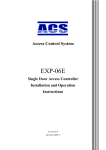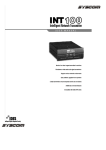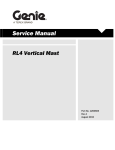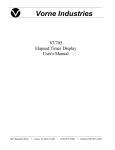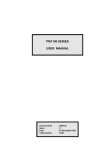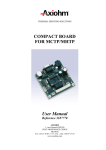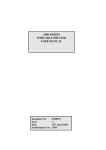Download PowerTronics - electri
Transcript
PowerTronics
Model PQR1010
Power Quality Recorder
User’s Manual
PQR Series
Model PQR-1010
Page 2
All information and specifications written or implied
in this manual are current at the time of printing.
However due to ongoing process of adding
improvements to the products, PowerTronics /
Eastern Time Designs, Inc. reserves the right to
make changes at any time without notice.
Copyright 2004
EASTERN TIME DESIGNS, INC.
SAFETY NOTICE
The power cable attached to the device is supplied
with a safety and reference ground. Do not use the
PQR 1010 when powered from an ungrounded
outlet.
High voltage exists at many points inside the
cabinet. Qualified personnel ONLY! should open
the covers. Opening the covers may affect the
warranty.
PQR Series
Model PQR-1010
Page 3
Table of Contents
PQR1010
Safety Notice
Table of Contents
Introduction
Calibration
Features
Apply the Test Signals
Testing AC Voltage
Testing DC Voltage
Testing Temperature
Testing Humidity
Testing Current
Power Up Sequence
2
3
5
6
7
10
11
12
13
14
15
16
Communications
Connecting to the PQR1010
PQR1010 Host Communications Software 18
Installing the Software
File Menu
View Menu
Settings Menu
Set Baud Rate
Set Data Log Rate
Communications Menu
Data Log Report
Data Log Graph
Detail Report
Summary Report
Calibration
PQR1010 Commands
C0 - Transmit the Command Menu
C1 - Transmit the Version Number
C2- Transmit a Summary Report
17
19
21
22
23
24
25
26
27
28
30
31
32
33
34
35
36
PQR Series
Model PQR-1010
Page 4
C3 - Transmit a Detail Report
C4 - Transmit a Data Log
C5 - Clear all events, and data log
C6 - Configure the hardware
Set the Date and Time
Set the Baud Rate
Set the Data Logging Rate
Set the Thresholds
C90 - Continuous Voltage readings
CX - Hang up the Phone
37
38
39
40
41
42
43
44
45
46
Specifications
AC Channels
DC Channels
Current Channel
Temperature Channel
Humidity Channel
Mechanical
Operating Specifications
Interface
Data Storage
47
48
49
49
50
50
50
50
50
Power Terminology
Types of Power Problems
Dropout - Power Failure
Sag
Impulse
Common Mode Noise
Surge
High Frequency Noise
51
52
53
54
55
56
57
PQR Series
Model PQR-1010
Page 5
INTRODUCTION
This reference guide is designed to aid PQR1010 users in the
interpretation of AC power line problems.
This unit will detect a wide range of power disturbances including
spikes, sags, surges, common mode noise, dropouts, and high
frequency noise on 2 phases of voltage and 1 DC Channel, as well as
test the Temperature, Humidity, and Current.
The PQR1010 is one of a series of practical power line monitors,
designed and priced to be outfitted to everyone who services or
installs three phase electrical, and electronic equipment.
Electronic equipment is damaged more often by power
disturbances than by fire, theft, and vandalism combined. Intermittent
power problems are the most expensive hidden expense to the owners
of microprocessor based equipment.
The PQR1010 is easy to use and provides immediate and long
term information for the technician and customer to understand
power line disturbances.
To monitor the AC and DC circuits with the PQR1010, connect
the test leads between the circuits to be tested, and the connectors
located on the back of the unit. Plug the line cord provided into a
standard 110 volt or 220 volt outlet. After running an internal self
test, the unit will start testing.
PQR Series
Model PQR-1010
Page 6
Included with the PQR1010
Each PQR1010 is supplied with a 6 foot power cord, RS232
communications cable with DB9F termination, Windows 98/NT/XP
data analysis software, temperature probe, one set of AC voltage test
leads and one set of DC voltage test leads. Humidity probe must be
ordered separately, model no. PQR-HUMIDITY
CALIBRATION
The PQR1010 monitors are designed to test the Power Line with a
high degree of accuracy. In this unit all measurements are referenced
to a state of the art, temperature compensated voltage source. It is
recommended that each unit be calibrated annually by the factory as
certain components may require calibration. Contact OMEGA for
details on returning your unit for calibration.
PQR Series
Model PQR-1010
Page 7
Power and Environmental
Quality Monitor
User - Friendly
Multi Channel - AC Voltage, DC Voltage, Current,
Humidity and Temperature
Disturbance Recorder and Voltage Logger
Easy to Understand Reports
Simple connection to a Computer or Terminal
Made in USA
The PQR1010 Power Quality Recorder is a state of the art,
fully integrated instrument which measures, records, and reports
power disturbances, aiding in the analysis of power quality in
medical, commercial and industrial applications.
Disturbances detected on multiple channels are recorded by
their time, date, magnitude, and duration in a non-volatile RAM
memory. This data is then retrieved from the analyzer through
its’ serial communications port.
Connections to the PQR1010 are made between the safety
connectors on the back of the unit, and the circuit panel to be
tested. The power to operate the unit comes from any standard
110v / 220v AC outlet. Once plugged in, the PQR1010
immediately begins testing the signals on the input connectors.
PQR Series
Model PQR-1010
Page 8
Monitor 2 AC Channels,
DC, Temperature and Humidity and Current
(with optional probes)
User - Friendly
Programmable
Multiple Phase Monitoring
Fast Impulse Detection
Easy to Understand Reports
Made in USA
The PQR1010 Power Line Analyzer provides a
complete analysis of your AC Power for a fraction of the
cost of other Monitors.
Disturbances detected on the Hot and Neutral Lines ,
as well as Temperature and Humidity channels are
recorded by their time, date, magnitude, and duration in a
non-volatile RAM memory. This data is then retrieved
from the analyzer through it’s serial communications
port.
The power to operate the unit comes from any
standard 110v / 220v AC outlet. Once plugged in, the
PQR1010 immediately begins testing the signals on the
input connectors.
PQR Series
Model PQR-1010
Page 9
Features
Measures all types of disturbances
*
*
*
*
*
*
Spikes
Sags
Line Frequency
Dropouts
Surges
Humidity
*
*
*
*
*
AC Voltage
Common Mode Noise
High Frequency Noise
Power Failures
Temperature
Simple to operate
1) Plug the power cord into a grounded outlet
2) Periodically connect to a computer for reports
Stores Disturbance events in non-volatile RAM
* 32,000 Events in all
* Will Data log all channels up to 32,000 readings
(22.75 Days @ 1 sample per minute)
GRAPHICS SOFTWARE INCLUDED!
Provided with the PQR1010 is the PQR HOST
COMMUNICATIONS Software. This software allows you to easily
download the data and display or print the DATALOG chart over
time, the PIE CHART of the summary of events or the
HISTOGRAM of the detail of events.
In addition to full Text Detail
and Summary reports, event
information such as the
Magnitude, Time, and Date of
each of the disturbances is also
reported.
PQR Series
Model PQR-1010
Page 10
Apply the Test Signals:
The Voltages you are testing can KILL
!
Only a
Licensed Electrician can connect the test
leads to a distribution panel. Please use Care
All signals to be tested are applied to the TEST input
jacks located on the back of the PQR1010.
Apply AC voltage to the AC inputs at AC-1 and AC-2,
Apply the DC inputs to Port marked DC-1,
Plug the Optional Current Probe into jacks marked CURRENT,
Plug the temp probe into the port marked AUXILIARY,
Plug the Optional Humidity probe into the port marked HUMIDITY.
Note:
All signals are referenced to the safety ground of the unit.
For both Safety reasons, and for the unit to measure
signals properly, The unit MUST have a safety ground.
(Plugging the PQR1010 into a grounded outlet will take
care of this)
PQR Series
Model PQR-1010
Page 11
Testing AC Voltage with the PQR1010
The PQR1010 has two channels of AC Voltage power line
analyzing which are designed to obtain the maximum amount of
useful data from the circuit under test, while requiring the minimum
amount of setup time.
Data from the two AC input connectors starts being
collected as soon as power is applied to the AC power connector
located on the back of the unit. Data will continue to be gathered
until the unit is powered down.
Long term voltage recording is known as Data Logging.
The PQR1010 samples the voltage on each of the AC inputs
continuously , and stores the average reading once each minute (or
at other selected intervals). There is enough data storage capacity in
the unit to collect these readings on both channels for 11 days.
The PQR1010 will continuously test the two phases of
voltage for Sags, Surges, Power Failures, Dropouts, Impulses, High
Frequency Noise, Line Frequency, and Phase changes. Any power
quality problems that exceed the preset thresholds will be recorded
in battery backed RAM, with the time and date stamp of the event.
There is enough data storage capacity in the unit to collect up to
1500 of these readings on both channels.
PQR1010 Side Panel
AC Inputs
PQR Series
Model PQR-1010
Page 12
Testing DC Voltage with the PQR1010
The PQR1010 has one channels for analyzing DC Voltage.
This channel has a maximum input of +/-50V for testing low
voltage supplies.
Data from the DC input connector starts being collected as
soon as power is applied to the AC power connector located on the
back of the unit. Data will continue to be gathered until the unit is
powered down.
The PQR1010 samples the voltage on the DC input
continuously, and stores the average reading once each minute (or at
other selected intervals). There is enough data storage capacity in
the unit to collect these readings on this channel for 11 days.
The PQR1010 will continuously test the DC input for Sags,
Surges, Power Failures, Dropouts, Impulses, and High Frequency
Noise. Any power quality problems that exceed the preset
thresholds will be recorded in battery backed RAM, with the time
and date stamp of the event. There is enough data storage capacity
in the unit to collect up to 1500 of these readings.
OM-PQR1010 Back Panel
DC Input
+/-50V
PQR Series
Model PQR-1010
Page 13
Testing Temperature with the PQR1010
The PQR1010 is equipped with a temperature input port.
The included Temperature probe may be plugged into this port to
provide Data logging and fault detection of the ambient temperature.
Data from the Temperature input port starts being collected
as soon as power is applied to the AC power connector located on
the back of the unit. Data will continue to be gathered until the unit
is powered down.
The PQR1010 samples the temperature port continuously,
and stores the average reading once each minute (Data Logging) (or
at other selected intervals). There is enough data storage capacity in
the unit to collect these readings for 11 days.
The PQR1010 will continuously test the Temperature input
for Sags, and Surges. Any deviations that exceed the preset
thresholds will be recorded in battery backed RAM, with the time
and date stamp of the event. There is enough data storage capacity
in the unit to collect up to 1500 of these readings.
OM-PQR1010 Back Panel
Temperature Port Input
PQR Series
Model PQR-1010
Page 14
Testing Humidity with the PQR1010
The PQR1010 is equipped with a Humidity input port. The
optional Humidity probe may be plugged into this port to provide
Data logging and fault detection of the ambient Humidity.
Data from the Humidity input port starts being collected as
soon as power is applied to the AC power connector located on the
back of the unit. Data will continue to be gathered until the unit is
powered down.
The PQR1010 samples the Humidity port continuously,
and stores the average reading once each minute (Data Logging) (or
at other selected intervals). There is enough data storage capacity in
the unit to collect these readings for 11 days.
The PQR1010 will continuously test the Humidity input for
Sags, and Surges. Any deviations that exceed the preset thresholds
will be recorded in battery backed RAM, with the time and date
stamp of the event. There is enough data storage capacity in the unit
to collect up to 1500 of these readings.
OM-PQR1010 Back Panel
Humidity Port Input
PQR Series
Model PQR-1010
Page 15
Testing Current with the PQR1010
The PQR1010 is equipped with a pair of banana jacks
designed to accept a Current Transducer (CT) The output of the CT
will provide the signal necessary for the PQR1010 to record data
about the quality of the line being tested.
Data from the CT starts being collected as soon as power is
applied to the AC power connector located on the back of the unit.
Data will continue to be gathered until the unit is powered down.
The PQR1010 samples the Current channel continuously,
and stores the average reading once each minute (or at other
selected intervals). There is enough data storage capacity in the unit
to collect these readings for 11 days.
The PQR1010 will continuously test the Current Channel
for Sags, and Surges. Any deviations that exceed the preset
thresholds will be recorded in battery backed RAM, with the time
and date stamp of the event. There is enough data storage capacity
in the unit to collect up to 1500 of these readings.
OM-PQR1010 Side Panel
Current Transducer
(CT) Input
PQR Series
Model PQR-1010
Page 16
Apply AC or DC Power:
There is a Unit Status LED on the back of the PQR1010. This
led is used to indicate system diagnostics status, and Channel
operational status.
When the PQR1010 is first connected to AC or DC power
(110VAC or 220 VAC, or 12/24V DC), it will go through a series of
power on diagnostics. The status of these tests can be seen in the
Channel Status LED located on the back panel. While the initial
tests are being executed, (approximately 10 seconds long) the Red
LED will be blinking. After the tests are completed, the LED will
turn off briefly, and then turn on steady.
The LED will blink for ten seconds, whenever there is a
disturbance detected on any input, or the serial port has been
accessed.
As soon as the diagnostics have completed, the PQR1010 is online, and monitoring the input channels. The unit should be left online testing for at least a 72 hour period.
OM-PQR1010 Side Panel
Status LED
PQR Power
AC
DC
PQR Series
Model PQR-1010
Page 17
Connecting to the PQR1010
DIRECT:
The serial port connector on the back of the PQR1010 is a 9 pin DB
style RS232. the pinout is a s follows:
Pin 2
Pin 3
Pin 5
Receive Data
Transmit Data
Ground
To establish a connection with this port and a PC, a Null modem cable
must be used. This type of cable connects the Transmit Data pin on
the PC to the Receive Data pin on the PQR1010, and the Transmit
Data pin on the PQR1010 to the Receive Data pin on the PC. It also
connects the Ground pins together.
The PQR1010 is configured to operate at 19,200 baud, with 8 data
bits, 1 stop bit, and no parity checking.
MODEM:
Use a straight cable (not a null modem) when connecting to a modem.
Power the PQR1010 and the Modem up at the same time after
connecting the cable, and the PQR1010 will auto config the Hayse
compatible Modem for auto answer mode, at 19,200 baud. If the
modem is not Hayse compatible, configure it to answer the phone on
2 rings, with a Baud rate of 19,200, 8 data bits, 1 stop bit, and no
parity checking.
PQR Series
Model PQR-1010
Page 18
PQR Host Communications Software:
The PQR1010 is provided with the Powertronics Host Communications Software. When the PQR1010 is connected
to a computer with a null modem cable, the Host software provides several functions:
Automatically connect to the PQR1010
Configure the PQR1010’s settings
Download data from the PQR1010 and Save on the computer
Generate Reports, Charts and Graphs from the downloaded data
PQR Series
Model PQR-1010
Page 19
Installing the PQR Host Communications Software
Put Disk 1 provided with your unit into your disk drive.
Select or Double click on SETUP
A series of files will be copied to your computer’s RAM
To prevent any software conflicts, you should close any other applications programs running before
continuing with the PQR Host software installation, then click on OK.
Click on the Computer Button to start the installation.
PQR Series
Model PQR-1010
Page 20
Clicking on CONTINUE
will allow the installation to
complete.
The PQR Host communications software can now be started.
Click on START
Select PROGRAMS
Select POWERTRONICS
This Screen is the starting
point for working with the
PQR D52.
PQR Series
Model PQR-1010
Page 21
File Menu
The "File" menu contains options for using data files that are stored on disk.
Open
Select the "Open" menu item to open a data
log, detail report, or summary report that is
stored on disk. After specifying the desired
file, the program will open a window that
contains the data from the file.
Close
Select the "Close" menu item to close the
active window.
Print
Select the "Print" option to send the active window to a printer. This menu item will display a
Print Dialog for the user to select which printer to use and to specify the desired settings.
Memory Files
The program will keep track of the last four files that have been used, and keep their names and
locations in memory. To reopen any of these files, simply select the menu item with the desired
file's name. The program will display the contents of the file in a new window.
Exit
Select the "Exit" menu item to close all windows and exit the program.
Other options that are sometimes shown:
Save
Select the "Save" menu item to save the active data file to its current file name and location.
Save As...
Select the "Save As..." menu item to save the active data file to a new file name and location.
PQR Series
Model PQR-1010
Page 22
View Menu
The "View" menu contains items used to control what tools are visible and available to the user
in the main program window.
Toolbar
Select the "Toolbar" menu item to toggle the toolbar. The toolbar contains the buttons for
opening and printing files.
Status Bar
Select the "Status Bar" menu item to toggle the status bar at the bottom of the main program
window. The status bar displays the program's current COM port and baud rate settings.
PQR Series
Model PQR-1010
Page 23
Settings Menu
The "Settings" menu contains items that allow the
user to specify certain settings for communication
between the software and the PQR device. The
menu also provides an interface for setting the
PQR device parameters.
COM Port 1 - COM Port 4
The "COM Port" menu items are used to specify which computer COM port the PQR device is
connected to. Selecting one of the options will change the program setting to that particular
port. The current settings are indicated by a check mark next in the Settings menu. The current
COM port setting is also displayed in the status bar at the bottom of the main program window.
Set Date/Time
Select the "Set Date/Time" menu
item to set the device date and
time.
A dialog box will be displayed
that provides the user an interface
with which to specify the date and
time.
The settings will be
defaulted to the current date and
time, or to the date and time
specified previously in the same
program session.
After inputting the desired date and time, pressing the "Okay" button will instruct the program
to set the device to the specified settings. This process may take a few seconds.
PQR Series
Model PQR-1010
Page 24
Set Baud Rate
The "Set Baud Rate" menu option allows the user to specify the data rate to be used when
communicating with the device. The program will display a dialog box with the six valid baud
rates to select from: 2400, 4800, 9600, 14400, 19200 and 38400. After selecting the desired
baud rate, pressing the "Okay" button will instruct the program to set the device baud rate. This
process may take a few seconds. The program baud rate setting will also be set to the selected
setting.
When the rate is changed, the new setting is saved in FLASH RAM, and is used as the power up
default until the next time the setting is changed.
PQR Series
Model PQR-1010
Page 25
Set Data Logger
The "Set Data Logger" menu item allows the
user to specify the device data logging rate, or
the time in between data log samples. The user
will be provided six choices: 1 second, 5
seconds, 10 seconds, 30 seconds, 1 minute, or 4
minutes. After selecting the desired logging
interval, pressing the "Okay" button will
instruct the program to set the device setting.
This process may take a few seconds.
When the rate is changed, the setting is NOT
saved in non-volatile RAM. The power up
default is one sample per minute.
Set Thresholds
The "Set Thresholds" menu item allows the user to
specify the thresholds at which the device will
trigger events. The user will be provided a dialog
box with input fields to specify the surge, sag, and
power failure thresholds for all available lines.
Entering zero will set the unit to test at 5% and 10%
limits. Entering a value between 1 and 999 will set
the actual voltage for the unit to trip at. Leaving a
field blank will keep the threshold set to its current
value. After specifying the desired settings, pressing
the "Okay" button will instruct the program to set
the device settings. This process may take a few
seconds
PQR Series
Model PQR-1010
Page 26
Communications Menu
The "Communications" menu contains
items that allow the user to retrieve data
from the PQR device.
When you click on any of these functions, the PQR Host Communications software will
automatically scan your serial ports looking for the connected PQR D52. The software will
attempt to match the communications settings to the PQR D52, and will then perform the
selected function.
For example, when you click on the Data Log report, the software will locate the PQR D52, and
start downloading the data. The status of the download is reported as:
The blocks will count up until all of the data is downloaded and saved in the data file.
PQR Series
Model PQR-1010
Page 27
Data Log
Selecting the "Data Log" menu item will download a listing of the voltages measured on all of
the input channels since the unit was put on-line and the RAM was cleared. Before starting the
transmission, the user will be asked to specify the name and location of a file to write the data to.
After the transfer is complete, the program will automatically open a data window containing the
downloaded data.
This is the text report showing the Date and Time of the reading, the voltage on each of the Hot
and Neutral Lines as well as the readings from the Temperature and Humidity sensors.
Notice that the Graph option now shows up on your toolbar. Since you now have data available,
you can generate the charts and graphs that represent that data.
PQR Series
Model PQR-1010
Page 28
Data Log Graph
Select the Plot Time History selection under Graph
Select 1 or 2 of the available channels to graph
Once the channels are selected, and the Okay button is clicked, the software will scan the data
file and generate a chart showing the data in chart form.
Data Log chart of Temperature and Humidity
PQR Series
Model PQR-1010
Page 29
This is the chart generated
from a days worth of data
logging on a 120V AC
Line.
the
By holding down your Left Mouse Button you create a
selection box. You can drag your mouse, and create a ZOOM
Area around your data. When you release the mouse button,
data in the ZOOM area is expanded to fill the screen area.
Double clicking on the chart will return it to original size.
PQR Series
Model PQR-1010
Page 30
Detail Report
Selecting the "Detail Report" menu item will download a listing of all the disturbances saved since
the unit was put on-line and the RAM was cleared. Before starting the transmission, the user will be
asked to specify the name and location of a file to write the data to. After the transfer is complete,
the program will automatically open a data window containing the downloaded data. Each event is
described by the date, time, phase, event type, and magnitude of that disturbance..
PQR Series
Model PQR-1010
Page 31
Summary Report
Selecting the "Summary Report" menu item will download a listing of counts of all the disturbances
detected since the unit was put on-line and the RAM was cleared. Before starting the transmission,
the user will be asked to specify the name and location of a file to write the data to. After the
transfer is complete, the program will automatically open a data window containing the downloaded
data. Each event is described by the phase, event type, magnitude, and quantity of that disturbance.
Selecting the Chart options from this report allows you to generate a pie chart showing the
distribution of the detected events.
PQR Series
Model PQR-1010
Page 32
Calibration Mode
Selecting the "Calibration Mode" menu item will
command the device to begin transmitting the current
voltage readings to the computer. The voltage readings
are then displayed in a special window. The voltage
readings will be updated approximately once a second.
No other command can be performed while the
program is in calibration mode.
To end the
transmission, user must press the "Stop Transmission"
button; otherwise, the transmission will automatically
stop after about two minutes.
Clear Data
Selecting the "Clear Data" menu item will clear all of the events and data log information stored
in the internal battery backed RAM in the device. The summary report quantities will be reset
to zero, and the data logging will start tracking voltage again. The program will ask the user for
confirmation before transmitting the "Clear" command to the device.
Note: A large amount of time may be necessary in the cases where data is transmitted from the
device to the computer. The exact duration is dependent upon the baud rate setting and the
amount of data being downloaded. In these cases ("Data Log", "Detail Report", and "Summary
Report"), a status window is displayed allowing the user to modify the progress of the
transmission. The status window shows a running count of blocks written to disk during the
current transmission. The block count provides an approximate measure of the amount of data
that has been transferred, and the actual size of a block depends on the baud rate setting. The
user can cut a transmission short by simply pressing the "Cancel" button.
PQR Series
Model PQR-1010
Page 33
Other Communications
In the event that you would like to communicate with the PQR 1010 without using the PQR Host
Communications software, you can connect using most other terminal emulator software.
Commands:
The PQR 1010 will respond to commands received through the serial port. All commands are
started with a C. Entering C, followed by the command number will initiate the function.
The commands are as follows:
C0
C1
Transmit the Command Menu
Transmit the Unit Version number
C2
C3
C4
Transmit a Summary Report
Transmit a Detail Report
Transmit a Data Log of recorded voltage
C5
C6
Clear all events, and data log
Set the Date and Time
C90
Continuous transmission of channels readings
CX
Hang up the phone
.
After the PQR 1010 has completed the task initiated by the operator command, it returns on-line
to it’s monitoring duties. Each of the commands are detailed in the following pages.
PQR Series
Model PQR-1010
Page 34
C0 - Transmit the Command Menu:
This command will transmit the Command Menu back to the
operator through the serial port. This is usually the first command to
be issued when the operator is connected to the PQR1010.
Transmit or type:
C0, or CONNECT
The PQR1010 will respond after after several seconds with:
This Menu can be called up any time the operator is connected to the unit,
PQR1010 V2.1 Aug. 01,00 11:05:32.53 - ID: 33271
These are your Command Options:
C0 C1 -
Display this Command List
Display Unit Version Number
C2 C3 C4 ESC SPACE
Summary of all Detected Events
Detail Report of Stored Events
Data Log Report of all Channels
Will STOP data transfer
Will Pause data transfers
C5 C6CX -
Clear All Events
Configure the PQR Hardware
Hang up
and the Menu is transmitted automatically upon receipt of the word
CONNECT from a modem.
PQR Series
Model PQR-1010
Page 35
C1 - Transmit the Version Number:
This command will transmit the Model Name and Version
Number back to the operator through the serial port.
Transmit or type:
C1
The PQR1010 will respond with:
PQR1010
Ver V2.1
** PQR SERIES ** Aug/01/00 - ID: 33271
The Version Number refers to the Firmware Program stored in the PROM
located inside the unit. This number is needed whenever the operator
contacts OMEGA technical support specialists.
PQR Series
Model PQR-1010
Page 36
C2 - Transmit a Summary Report:
Transmit or type:
C2
The PQR1010 will respond by transmitting a report that is a count of
all the disturbances detected since the unit was put on-line, and the
RAM was cleared:
PQR1010
Ver V2.1 - Summary Report as of Aug/01/00 - ID: 33271
AC Ch 1,
AC Ch 1
AC Ch 1
AC Ch 1
Impulse - 120V
Impulse - 60V
Impulse - 20V
5 Percent Sag
4
1
7
2
AC Ch 2
AC Ch 2
AC Ch 2
AC Ch 2
Impulse - 120V
Impulse - 60V
Impulse - 20V
5 Percent Sag
4
2
4
2
DC Ch 1
DC Ch 1
DC Ch 1
DC Ch 1
Impulse - 500V
Impulse - 60V
Impulse - 20V
5 Percent Sag
1
6
2
2
Each event type is described by the Channel Number, Event Type,
Magnitude, and Quantity of that disturbance.
Typing, or Transmitting the Escape character at any time will terminate the
transmission of this report.
PQR Series
Model PQR-1010
Page 37
C3 - Transmit a Detail Report:
Transmit or type:
C3
The PQR1010 will respond by transmitting the Detail Report of all
disturbances saved since the unit was put on-line, and the RAM was
cleared:
PQR1010
Ver V2.1 - Detail Report as of Aug/01/00 - ID: 33271
Aug,29,00,
Aug,29,00,
Aug,29,00,
Aug,29,00,
Aug,29,00,
Aug,29,00,
Aug,29,00,
Aug,29,00,
Aug,29,00,
Aug,29,00,
Aug,29,00,
Aug,29,00,
Aug,29,00,
Aug,29,00,
Aug,29,00,
Aug,29,00,
Aug,29,00,
Aug,29,00,
Aug,29,00,
Aug,29,00,
Aug,29,00,
07:31:29.53,
07:32:05.02,
07:32:05.02,
07:43:30.85,
07:59:43.32,
08:01:26.22,
08:09:44.72,
08:11:26.92,
09:15:22.57,
09:18:33.23,
09:32:19.56,
09:32:19.56,
09:43:27.33,
10:01:29.74,
10:01:29.74,
10:01:29.74,
10:10:52.32,
10:10:52.32,
10:10:52.32,
10:10:52.32,
11:35:22.47,
AC Ch 1,
AC Ch 2,
DC Ch 1,
AC Ch 2,
DC Ch 1,
AC Ch 1,
DC Ch 1,
DC Ch 2,
DC Ch 1,
AC Ch 2,
AC Ch 1,
DC Ch 2,
AC Ch 1,
AC Ch 1,
AC Ch 2,
DC Ch 1,
AC Ch 1,
AC Ch 2,
DC Ch 1,
DC Ch 2,
DC Ch 1,
Impulse, 20,V Peak,
Impulse, 20,V Peak,
Impulse, 20,V Peak,
Impulse, 120,V Peak,
Impulse, 60,V Peak,
Impulse, 120,V Peak,
Impulse, 600,V Peak,
Impulse, 20,V Peak,
Impulse, 20,V Peak,
Impulse, 60,V Peak,
Impulse, 120,V Peak,
Impulse, 20,V Peak,
Impulse, 60,V Peak,
Sag, 5,Percent,
Sag, 5,Percent,
Sag, 5,Percent,
Impulse, 120,V Peak,
Impulse, 120,V Peak,
Impulse, 60,V Peak,
Impulse, 20,V Peak,
Impulse, 60,V Peak,
Each event is described by the Time, Date, Channel Number, Event Type,
and Magnitude of that disturbance.
Typing, or Transmitting the Escape character at any time will terminate the
transmission of this report.
Typing the Space bar will Pause or re-start the report.
PQR Series
Model PQR-1010
Page 38
C4 - Transmit a Data Log Report:
C4
Transmit or type:
The PQR1010 will respond by transmitting the Listing of the voltages
measured on all input channels each minute (or at other programmed
time) since the unit was put on-line, and the RAM was cleared:
PQR1010 Ver V2.1 - Data Log Report as of Sep/01/00 - ID: 33271
Aug/29/00, 12:13:00, AC1,
Aug/29/00, 12:14:00, AC1,
Aug/29/00, 12:15:00, AC1,
Aug/29/00, 12:16:00, AC1,
Aug/29/00, 12:17:00, AC1,
Aug/29/00, 12:18:00, AC1,
Aug/29/00, 12:19:00, AC1,
Aug/29/00, 12:20:00, AC1,
Aug/29/00, 12:21:00, AC1,
Aug/29/00, 12:22:00, AC1,
Aug/29/00, 12:23:00, AC1,
Aug/29/00, 12:24:00, AC1,
Aug/29/00, 12:25:00, AC1,
Aug/29/00, 12:26:00, AC1,
Aug/29/00, 12:27:00, AC1,
Aug/29/00, 12:28:00, AC1,
Aug/29/00, 12:29:00, AC1,
Aug/29/00, 12:30:00, AC1,
Aug/29/00, 12:31:00, AC1,
Aug/29/00, 12:32:00, AC1,
Aug/29/00, 12:33:00, AC1,
Aug/29/00, 12:34:00, AC1,
Aug/29/00, 12:35:00, AC1,
Aug/29/00, 12:36:00, AC1,
Aug/29/00, 12:37:00, AC1,
Aug/29/00, 12:38:00, AC1,
Aug/29/00, 12:39:00, AC1,
Aug/29/00, 12:40:00, AC1,
Aug/29/00, 12:41:00, AC1,
Aug/29/00, 12:43:00, AC1,
119,
119,
118,
118,
118,
117,
117,
117,
118,
117,
118,
118,
118,
118,
119,
119,
119,
119,
119,
119,
119,
119,
118,
118,
117,
115,
115,
115,
116,
118,
AC2,
AC2,
AC2,
AC2,
AC2,
AC2,
AC2,
AC2,
AC2,
AC2,
AC2,
AC2,
AC2,
AC2,
AC2,
AC2,
AC2,
AC2,
AC2,
AC2,
AC2,
AC2,
AC2,
AC2,
AC2,
AC2,
AC2,
AC2,
AC2,
AC2,
118,
118,
118,
118,
118,
118,
117,
117,
117,
118,
118,
118,
118,
118,
118,
118,
119,
119,
119,
118,
118,
118,
118,
118,
118,
117,
117,
117,
117,
118,
Temp,
Temp,
Temp,
Temp,
Temp,
Temp,
Temp,
Temp,
Temp,
Temp,
Temp,
Temp,
Temp,
Temp,
Temp,
Temp,
Temp,
Temp,
Temp,
Temp,
Temp,
Temp,
Temp,
Temp,
Temp,
Temp,
Temp,
Temp,
Temp,
Temp,
68, HUM,
68, HUM,
68, HUM,
68, HUM,
68, HUM,
69, HUM,
69, HUM,
69, HUM,
69, HUM,
68 HUM,
68, HUM,
65, HUM,
65, HUM,
65, HUM,
65, HUM,
65, HUM,
66, HUM,
66, HUM,
66, HUM,
66, HUM,
67, HUM,
67, HUM,
67, HUM,
67, HUM,
68, HUM,
68, HUM,
68, HUM,
69, HUM,
69, HUM,
69, HUM,
54,
54,
54,
54,
54,
54,
54,
54,
54,
54,
54,
54,
54,
54,
54,
54,
54,
54,
54,
54,
53,
53,
53,
52,
52,
52,
52,
52,
54,
54,
DC,
DC,
DC,
DC,
DC,
DC,
DC,
DC,
DC,
DC,
DC,
DC,
DC,
DC,
DC,
DC,
DC,
DC,
DC,
DC,
DC,
DC,
DC,
DC,
DC,
DC,
DC,
DC,
DC,
DC,
30, Cur,
30, Cur,
30, Cur,
32, Cur,
32, Cur,
32, Cur,
32, Cur,
32, Cur,
34, Cur,
34, Cur,
34, Cur,
34, Cur,
32, Cur,
32, Cur,
32, Cur,
32, Cur,
32, Cur,
30, Cur,
30, Cur,
30, Cur,
31, Cur,
31, Cur,
32, Cur,
32, Cur,
32, Cur,
32, Cur,
32, Cur,
32, Cur,
32, Cur,
32, Cur,
9A
9A
10A
10A
11A
11A
11A
11A
11A
11A
11A
10A
10A
10A
9A
9A
9A
9A
10A
11A
11A
12A
16A
17A
17A
14A
10A
9A
9A
8A
Each line of the transmission has the Time and Date that the data was
recorded, and the sample of the average reading summed for one minute.
Typing, or Transmitting the Escape character at any time will terminate the
transmission of this report.
Typing the Space bar will Pause or re-start the report.
PQR Series
Model PQR-1010
Page 39
C5 - Clear all events, and data log:
This Command will clear all of the events, and all of the
Data log information stored in the internal Battery backed RAM. The
summary report quantities will be reset to zero, and the Data Logging
will start tracking voltage again.
Transmit or type:
C5
The PQR1010 will respond by transmitting the following message
Are You Sure you want to CLEAR ALL DATA on this board ? Y
To clear the data, answer this question with a CAPITAL Y
The unit will then test and clear all internal RAM.
The following text will be transmitted during the RAM clear
operation.
Are You Sure you want to CLEAR ALL DATA on this board ? Y
Testing RAM |————————————| - Ram test Passed
Clearing Ram ......................... Done
PQR Series
Model PQR-1010
Page 40
C6 - Configure the PQR Hardware:
This command will transmit the Setup Command Menu back
to the operator through the serial port.
Transmit or type:
C6
The PQR1010 will respond with:
These are your Setup Options:
1
2
3
4
Current Settings:
- Set the Date and Time
Aug. 01,00 11:05:32.53
- Set the Baud Rate
19.200 Baud
- Select a Data Logging Sample Rate
1 Minute
- Set the Sag, Surge, and Power Fail Thresholds
ESC - Exit this Menu
Select an Option
This Menu can be called up any time the operator is connected to the unit.
The Current Settings show how the OM-PQR1010 is configured at that time.
PQR Series
Model PQR-1010
Page 41
C6 - (Option 1) Set the Date and Time:
This Command allows the operator to change the Time and
Date setting inside the OM-PQR1010.
Select Option 1:
1
The PQR1010 will respond by transmitting the following message
Input the Date and Time in the format MM/DD/YY,HH:MM:SS
MM = Month,
Jan = 01, Feb = 02, Mar = 03,
Apr = 04, May = 05, Jun = 06,
Jul = 07, Aug = 08, Sep = 09,
Oct = 10, Nov = 11, Dec = 12
DD = Day
1st = 01, ... 31st = 31
YY = Year
2001 = 01
HH = Hour
1:00 AM = 01,
MM = Minute
0 = 00, 59 = 59
SS =
0 = 00, 59 = 59
Second
1:00 PM = 13
The data must be entered in the format shown, including commas
slashes, and colons. After entering the Time and Date, enter a
Carriage Return.
PQR Series
Model PQR-1010
Page 42
C6 - (Option 2) Set the Baud Rate:
This Command allows the operator to change the
communications Baud rate setting inside the PQR1010.
Select Option 2:
2
The PQR1010 will respond by transmitting the following message
Select a Baud Rate
- Currently set to 19,200 Baud
1) 1200
4) 9600
2) 2400
5) 14400
3) 4800
4) 19200
Warning - You will need to change the rate on your terminal to match the
PQR
Typing the number indicated next to the desired rate will change the
rate of the PQR1010 immediately to the new rate
Note:
Changing the baud rate breaks the connection between the
PQR1010 and the communications device it is connected to. The rate
on the connected device must be changed to match the new rate of the
PQR1010.
When the rate is changed, the new setting is saved in NonVolatile RAM, and is used as the power up default until the next time
the setting is changed.
PQR Series
Model PQR-1010
Page 43
C6 - (Option 3) Set the Data Logger:
This Command allows the operator to change the interval
between data logger readings inside the PQR1010.
Select Option 3:
3
The PQR1010 will respond by transmitting the following message
Enter the number of seconds between Data log samples
1) 1 Sec
2) 5 Sec
3) 10 Sec
4) 30 Sec
5) 1 Min
4) 4 Min
Any other choice sets the rate to 1 Minute.
New Rate:
Typing the number indicated next to the desired rate will change the
rate of the PQR1010 immediately to the new rate
Note:
When the rate is changed, the new setting is saved in NonVolatile RAM, and is used as the power up default until the next time
the setting is changed.
PQR Series
Model PQR-1010
Page 44
C6 - (Option 4) Set the Surge, Sag, and Power Fail:
This Command allows the operator to change the threshold
points for the PQR1010 events.
Select Option 4:
4
The PQR1010 will respond by transmitting the following message
AC channel - Surge Threshold ........ : (5%, 10%) .. :
AC channel - Sag Threshold ............ : (5%, 10%) .. :
AC channel - Power Failure ............ : (5%, 10%) .. :
DC Channel - Surge Threshold ........ : (5%, 10%) .. :
DC Channel - Sag Threshold ............ : (5%, 10%) .. :
DC Channel - Power Failure ............ : (5%, 10%) .. :
Temp channel - Surge Threshold ........ : (5%, 10%) .. :
Temp channel - Sag Threshold ............ : (5%, 10%) .. :
To set a fixed threshold, type the desired number of the setting:
To set the Temperature Surge setting to 98 degrees, type 98 at
Temp channel - Surge Threshold .... : (5%,10%) .. : 98
followed by a carriage return.
The PQR1010 will calculate the nearest trip point, and respond (96d),
indicating that it will now trip at 96 degrees.
To set the Temperature Surge setting to trip at 5% and 10%, type 0 at
Temp channel - Surge Threshold .... : (5%,10%) .. : 0
followed by a carriage return.
The PQR1010 will respond (5%,10%), indicating that it will now
trip at 5% and 10% above the average value.
Note:
These settings are saved in Non-Volatile RAM, and are used
as the power up default.
PQR Series
Model PQR-1010
Page 45
C90 - Continuous Transmission of channels voltage:
This Command allows the operator to view the readings
present on each of the AC, DC Aux, and Current channels.
Transmit or type:
C90
The PQR1010 will respond by transmitting the following:
Unit Off-Line - entering Calibration mode
Ph1: 120V Ph2: 117V Aux: 68
Unit returning to On-Line mode
DC1 +6.3V
DC2: 413V Cur: 11A
The unit will send this reading continuously, resulting in the screen
being updated about three times a second.
This command is helpful in confirming the unit is properly connected
to the signals under test. If there is no signal attached to the test
input, the reading will be zero.
To quit the test, send any character to the unit, or wait for 30 seconds
when the unit will return to the on-line testing mode on it’s own.
PQR Series
Model PQR-1010
Page 46
CX - Hang up the phone:
This Command allows the operator to disconnect the signal
from a phone line on a Modem attached to the PQR1010.
Transmit or type:
CX
The PQR1010 will respond by transmitting the following:
Thank you, and good bye.
+++ ATH0
Having sent this message, the unit then sends the hang-up command
to the modem. If there is a modem connected, and it had the phone
off-hook, it would put the phone on-hook.
PQR Series
Model PQR-1010
Page 47
AC Channels Specifications
RMS Voltage
Range:
Accuracy:
Sample rate:
(Data Logging):
80 - 480 Vac RMS
+/- 1.5%
Programmable - range 1 reading per
second to 1 reading per 4 minutes
Sags/Surges:
Threshold:
Duration limits:
Accuracy:
5% and 10% of average RMS
1 cycle or 20 milliseconds
+/- 1.5%
Dropouts:
Threshold:
Duration limits:
Less than 10V rms
Longer than 8 ms, Shorter than 80ms
Power Failure:
Threshold:
Duration limits:
Less than 10V rms
Longer than 80ms
Impulses:
2 Channels:
Resolution:
Accuracy:
Pulse detection:
20V to > 2500 Vpeak
thresholds 5 volt steps
+/- 10%
500 nano seconds above threshold
High Frequency Noise:
Range:
Accuracy:
Response time:
2 volts peak, 10 Khz - 10 Mhz
+/- 10%
1 milli second
Line Frequency:
Range:
Accuracy:
Response time:
Threshold:
40 - 400 Hz
+/- 1%
1 AC cycle
+/- 2% deviation from average
PQR Series
Model PQR-1010
Page 48
DC Channel Specifications
RMS Voltage
Ch #1 Range:
Accuracy:
Sample rate:
(Data Logging):
+/-1 to +/-52 Vdc
+/- 1.5%
Programmable - range 1 reading per
second to 1 reading per 4 minutes
Sags/Surges:
Threshold:
Duration limits:
Accuracy:
5% and 10% of average
20 milliseconds
+/- 1.5%
Dropouts:
Threshold:
Duration limits:
Less than 10% of average
Longer than 8 ms, Shorter than 80ms
Power Failure:
Threshold:
Duration limits:
Less than 10% of average
Longer than 80ms
Impulses:
2 Channels:
Resolution:
Accuracy:
Pulse detection:
20V to > 2500 Vpeak
thresholds 5V steps
+/- 10%
500 nano seconds above threshold
High Frequency Noise:
Range:
Accuracy:
Response time:
2 volts peak, 10 Khz - 10 Mhz
+/- 10%
1 milli second
PQR Series
Model PQR-1010
Page 49
Current Channel
RMS Current
Range:
Accuracy:
Sample rate:
(Data Logging):
0.2 amps to 1000 amps rms
+/- 1.5%
Programmable - range 1 reading per
second to 1 reading per 4 minutes
Sags/Surges:
Threshold:
Duration limits:
Accuracy:
5% and 10% of average
20 milliseconds
+/- 1.5%
Dropouts:
Threshold:
Duration limits:
Less than 10% of average
Longer than 8 ms, Shorter than 80ms
Power Failure:
Threshold:
Duration limits:
Less than 10% of average
Longer than 80ms
Temperature Channel
Temperature:
Range:
Accuracy:
Sample rate:
(Data Logging):
20 to 250 degrees (0.02 - 2.5 vdc)
+/- 1%
Programmable - range 1 reading per
second to 1 reading per 4 minutes
Sags/Surges:
Threshold:
Duration limits:
Accuracy:
5% and 10% of average
2 seconds
+/- 1.5%
PQR Series
Model PQR-1010
Page 50
Humidity Channel
Humidity:
(Data Logging):
Range:
Accuracy:
Sample rate:
20 to 250 degrees (0.02 - 2.5 vdc)
+/- 1%
Programmable - range 1 reading per
second to 1 reading per 4 minutes
Sags/Surges:
Threshold:
Duration limits:
Accuracy:
5% and 10% of average
2 seconds
+/- 1.5%
Mechanical Specifications
Weight:
Size:
Power Cord:
4 pounds
8” wide x 10” deep, x 2” high
6 feet
Operating Specifications
Temperature:
Humidity:
AC Voltage :
DC Voltage:
Current :
Line Frequency:
0 - 50 degrees C
10% to 80% (non condensing)
80 - 260 volts ac
12 - 30 volts dc
0.1 amp
DC - 400 Hz
Serial Interface Specifications
Connector:
Baud Rate:
Protocol
DB9 - RS 232C
Programmable - 1200 to 19,200 baud
8 Data, 1 Stop, No Parity bits
Data Storage Specifications
Summary Event Count:
Detail Storage:
Data Retention:
56,000 of each event type
56,000 events total
99 Years without power
PQR Series
Model PQR-1010
Page 51
Types of Power Problems
and what they look like.
There are many types of power problems that can affect
the quality of the AC power being delivered to a piece of
equipment. Different types of problems will have different effects
on the operation, or even life expectancy of this equipment.
Knowing what these problems are, and what some of the
consequences are of having these problems, can help in the process
of identifying what can be done to help protect this equipment.
The following pages describe several of the more common
types of Power disturbances, and list what some of the causes are.
Dropout - Power Failure
Sag
Impulse
Common Mode Noise
Surge
High Frequency Noise
Figure PT 1
Typical AC Waveform
PQR Series
Model PQR-1010
Page 52
DROPOUT (NOTCH)
A condition where a portion of the sine wave has a lower
than expected value or is missing entirely, usually for a
portion of a cycle. These types of problems can be caused
when large motors are started, Lightning arresters are
employed (during a lightning hit), or when electrical
equipment fails. Dropouts can lead to failures in
computers and electronic equipment , reduced life of
motors and flickering lights.
POWER FAILURE
When the duration of a dropout exceeds 1 cycle it is
usually referred to as a Power Failure, or Blackout. This
problem is the easiest to observe.
Figure PT 2 - Dropout
PQR Series
Model PQR-1010
Page 53
SAG
(UNDER-VOLTAGE, DIP, or BROWNOUT)
A power sag (or low line voltage) is a decrease in line
voltage of at least 10% of the average line voltage for half
a cycle or longer. The power sag is often caused by large
inductive equipment (e.g. photocopy, postage equipment)
being applied on the same AC line as is being tested. Sags
can be caused by external factors as well, such as large
power draining equipment used in other buildings. Sags
can be particularly detrimental to electronic equipment
because of the malfunctions caused by the sudden
decrease of available voltage to the power supply.
Complete failure rarely occurs, and often the equipment
user continues to operate the device, unaware of the
potential logic circuit problems that may have occurred.
Figure PT 3 - Sag
PQR Series
Model PQR-1010
Page 54
IMPULSE
(SPIKE, SURGE)
The spike is a surge of energy superimposed on the AC
line, usually with a relatively short duration. Spikes can
potentially have the most serious effects on electronic
equipment due to their high energy content, and the
Integrated Circuits inability to absorb the energy. Many
events can cause spikes, such as lightning bolts, utility
grid switching, switching inductive loads on and off, and
SCR (Silicon Control Rectifier) dimmers. Although
properly designed equipment has some built-in spike
protection, repeated hits by high energy spikes can
eventually render these components useless.
Figure PT 4 - Impulse
PQR Series
Model PQR-1010
Page 55
COMMON MODE NOISE
In single phase power systems, as found in many
countries such as the USA, the load (computer or
equipment) is connected between the hot and neutral
line. Usually the neutral line is connected to earth
ground at the service entrance, so that in effect the
neutral line should have 0 volts at the load. At a typical
site, voltage is induced onto the neutral line by other
equipment. This voltage can appear in the form of
impulses, or a continuous pseudo sine wave.
Figure PT 5 - Common Mode Noise
PQR Series
Model PQR-1010
Page 56
SURGE
(SWELL OR OVER-VOLTAGE)
A power surge is the opposite of a sag and is often
referred to as "High Line Voltage". A surge is defined as
an increase in line voltage above 128 volts (on a 115V
Line) for a half cycle or longer. Like the sag, the power
surge is often caused by large inductive loads being
applied on the same line. Power surges cause some of the
most dangerous occurrences, and their results are the most
difficult to correct.
Figure PT 6
Surge
PQR Series
Model PQR-1010
Page 57
HIGH FREQUENCY NOISE
High frequency noise can be caused by electronic
equipment feeding internal noise back onto the power line,
or logic induced noise from switching power supplies.
This noise is transferred to the AC line causing
disturbances greater than 2V peak-to-peak superimposed
on the AC sine wave (normal mode noise). This noise can
cause internal component degradation and eventual
system failure. During this degradation period, system
lockups, resets and data transfer will increase.
Figure PT 7 - High Frequency Noise



























































